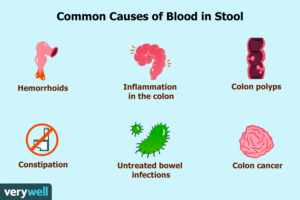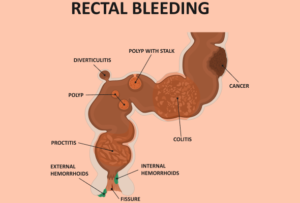H1: Introduction to Blood in Stool
- What is blood in stool?
- Why should you take it seriously?
H2: Common Causes of Blood in Stool
- H3: Hemorrhoids
- What are hemorrhoids?
- How do hemorrhoids cause blood in stool?
- H3: Anal Fissures
- What are anal fissures?
- The role of diet and constipation in anal fissures
- H3: Diverticulosis
- What is diverticulosis?
- Its role in bleeding in the digestive tract
- H3: Gastrointestinal Infections
- How infections can lead to bloody stools
- Bacterial and viral causes
- H3: Inflammatory Bowel Disease (IBD)
- Ulcerative colitis and Crohn’s disease
- How IBD can cause bleeding
- H3: Colon Polyps and Cancer
- What are colon polyps?
- The link between colon cancer and blood in stool
H2: Symptoms Associated with Blood in Stool
- H3: Bright Red Blood vs. Dark Blood
- Understanding the difference
- H3: Other Accompanying Symptoms
- Diarrhea, abdominal pain, and fatigue
H2: Diagnosing the Cause of Blood in Stool
- H3: Medical History and Physical Examination
- Why your doctor asks about your history
- H3: Stool Tests
- What can stool samples reveal?
- H3: Endoscopy and Colonoscopy
- How these procedures help in diagnosis
H2: Treatment Options for Blood in Stool
- H3: Lifestyle and Dietary Changes
- The role of fiber and hydration
- H3: Medications for Treating Hemorrhoids and Fissures
- Over-the-counter and prescription options
- H3: Surgery for Severe Cases
- When surgical intervention is necessary
- H3: Treating Underlying Conditions
- Managing IBD, infections, and polyps
H2: Preventing Blood in Stool
- H3: Importance of a Fiber-Rich Diet
- How diet affects bowel movements
- H3: Staying Hydrated
- The connection between water intake and digestive health
- H3: Regular Exercise
- How staying active helps prevent constipation
H2: When to See a Doctor
- H3: Signs of a Medical Emergency
- When blood in stool warrants immediate attention
- H3: Persistent or Recurrent Symptoms
- When to seek medical advice for ongoing issues
H1: Conclusion
- Summarize key points
- Stress the importance of seeking medical help
H2: FAQs
- H3: Is blood in stool always serious?
- H3: Can blood in stool be caused by something I ate?
- H3: How is blood in stool related to hemorrhoids?
- H3: What can I do to prevent blood in stool?
- H3: How long can I wait before seeing a doctor for blood in stool?
Blood in Stool: Understanding Causes, Symptoms, and Treatment
Blood in the stool is something that no one wants to experience, but it’s a common symptom with a variety of causes. Sometimes, the sight of blood in stool can be alarming, while other times it can go unnoticed, hidden within the stool itself. This article will walk you through everything you need to know about blood in stool, its causes, symptoms, and what to do if you experience it.
What is Blood in Stool?
Blood in stool refers to the presence of blood that either mixes with or coats the surface of stool. It can range from bright red to dark, almost black, depending on where the bleeding is coming from in your digestive tract. Regardless of color, blood in stool should never be ignored, as it often indicates an underlying health issue that needs to be addressed.
Why Should You Take Blood in Stool Seriously?
While it might not always signal a life-threatening condition, blood in stool can be a symptom of a significant problem. Whether it’s a minor issue like hemorrhoids or a more serious condition like colorectal cancer, identifying the cause is crucial for appropriate treatment and peace of mind.
Common Causes of Blood in Stool
There are several reasons why blood may appear in stool. Understanding these causes can help you recognize when to seek medical attention.
Hemorrhoids
Hemorrhoids are swollen blood vessels in the rectum or anus that can rupture and bleed, especially during bowel movements. This is one of the most common causes of blood in stool, particularly if you notice bright red blood.
Anal Fissures
An anal fissure is a small tear in the lining of the anus, often caused by straining during bowel movements or passing hard stools. These fissures can lead to pain and bleeding, often appearing as bright red blood.
Diverticulosis
Diverticulosis refers to small pouches that form in the walls of the colon. When these pouches become inflamed or infected, they can cause bleeding, which may appear as blood in your stool.
Gastrointestinal Infections
Certain bacterial, viral, and parasitic infections can cause inflammation in the digestive tract, leading to diarrhea mixed with blood. Infections like these require prompt medical treatment.
Inflammatory Bowel Disease (IBD)
Conditions like ulcerative colitis and Crohn’s disease, both types of IBD, can cause chronic inflammation in the intestines, which leads to bleeding. Blood in the stool is often accompanied by other symptoms like abdominal pain and diarrhea.
Colon Polyps and Cancer
Polyps are abnormal growths in the colon that can bleed. While not all polyps are cancerous, some can turn into colon cancer over time. Early detection through screening can prevent this.
Symptoms Associated with Blood in Stool
Bright Red Blood vs. Dark Blood
Blood in stool can appear bright red or dark, and the color offers clues about where the bleeding is happening. Bright red blood typically indicates bleeding from the lower part of the digestive tract, like hemorrhoids or fissures, while darker, almost black blood suggests an issue higher up, such as in the stomach or small intestines.
Other Accompanying Symptoms
In addition to blood in the stool, you might experience other symptoms depending on the underlying cause. These can include diarrhea, abdominal pain, fatigue, and unexplained weight loss. Pay attention to these signs, as they can offer important clues to your doctor.
Diagnosing the Cause of Blood in Stool
If you notice blood in your stool, your doctor will perform a variety of tests to determine the cause.
Medical History and Physical Examination
Your doctor will start by asking about your symptoms, diet, and family medical history. A physical examination, particularly of the rectal area, may help identify hemorrhoids or fissures.
Stool Tests
A stool sample can reveal hidden (occult) blood and help diagnose infections or other issues. These tests are often the first step in pinpointing the cause.
Endoscopy and Colonoscopy
For a closer look at the digestive tract, your doctor may recommend an endoscopy or colonoscopy. These procedures allow for a direct view of the inside of your intestines and colon, helping to identify polyps, ulcers, or cancer.

Treatment Options for Blood in Stool
Once the cause of the blood is identified, treatment will focus on resolving the underlying issue.
Lifestyle and Dietary Changes
For issues like hemorrhoids and anal fissures, increasing your fiber intake and staying hydrated can help soften stools and prevent straining during bowel movements.
Medications for Treating Hemorrhoids and Fissures
Over-the-counter creams and ointments can reduce pain and inflammation. In some cases, your doctor may prescribe stronger medications to alleviate discomfort.
Surgery for Severe Cases
If hemorrhoids or fissures become chronic or severe, surgical options may be considered. For more serious conditions like diverticulosis or colon cancer, surgery may be necessary to remove affected parts of the intestine.
Treating Underlying Conditions
For IBD or infections, targeted treatments like anti-inflammatory drugs, antibiotics, or antivirals are essential for managing the condition and preventing further bleeding.
Preventing Blood in Stool
Importance of a Fiber-Rich Diet
Eating plenty of fiber-rich foods like fruits, vegetables, and whole grains helps keep your digestive system functioning smoothly and reduces the risk of constipation and hemorrhoids.
Staying Hydrated
Drinking enough water is essential for maintaining healthy bowel movements. Dehydration can lead to hard stools, increasing the risk of anal fissures.
Regular Exercise
Staying physically active promotes regular bowel movements and can prevent constipation, reducing the likelihood of bleeding.
When to See a Doctor
Signs of a Medical Emergency
If you experience large amounts of blood in your stool, severe abdominal pain, dizziness, or fainting, seek medical help immediately, as these can be signs of a life-threatening condition.
Persistent or Recurrent Symptoms
Even if the bleeding is minor, if it persists or recurs, it’s important to consult a doctor to rule out serious conditions.
Conclusion
Blood in stool can be a frightening symptom, but understanding the potential causes and knowing when to seek medical help can make all the difference. While some causes are minor and easy to treat, others may require more intensive care. Always consult a healthcare professional to ensure proper diagnosis and treatment.
FAQs
Is blood in stool always serious?
Not always. Minor issues like hemorrhoids can cause blood in the stool, but it’s still important to consult a doctor to rule out more serious conditions.
Can blood in stool be caused by something I ate?
Foods like beets or red food coloring can make stool appear red, but this is not the same as blood in stool. It’s essential to identify the actual source of the blood.
How is blood in stool related to hemorrhoids?
Hemorrhoids can cause blood to appear in stool, especially if they are swollen or ruptured. The blood is usually bright red and found on the surface of the stool.
What can I do to prevent blood in stool?
A high-fiber diet, staying hydrated, and regular exercise can help prevent constipation, hemorrhoids, and other causes of blood in stool.
How long can I wait before seeing a doctor for blood in stool?
If the blood is persistent, increasing in volume, or accompanied by other symptoms like pain or weight loss, seek medical attention immediately


Hi! Do you know if they make any plugins to help with SEO?
I’m trying to get my website to rank for some targeted keywords but I’m not seeing very
good success. If you know of any please share. Appreciate it!
You can read similar article here: Wool product
Sorry to say but, i can’t guess what suites you